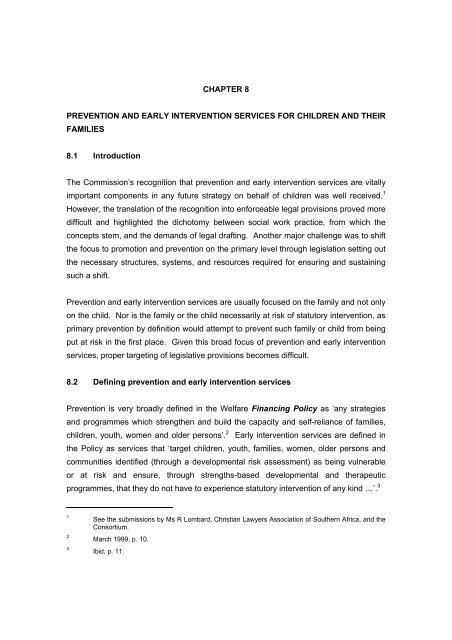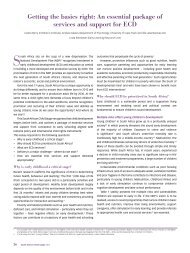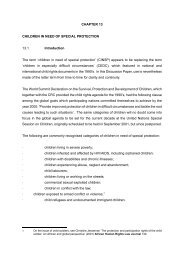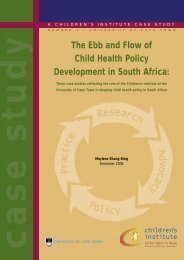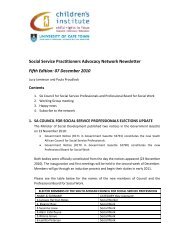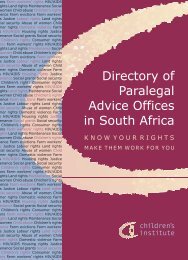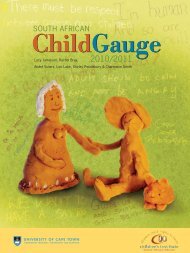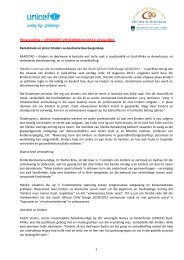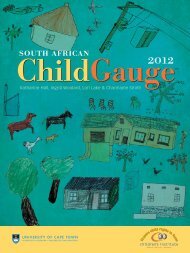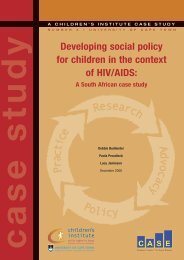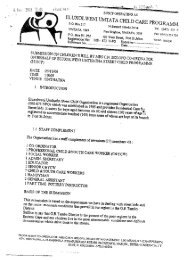CHAPTER 8 PREVENTION AND EARLY INTERVENTION ...
CHAPTER 8 PREVENTION AND EARLY INTERVENTION ...
CHAPTER 8 PREVENTION AND EARLY INTERVENTION ...
You also want an ePaper? Increase the reach of your titles
YUMPU automatically turns print PDFs into web optimized ePapers that Google loves.
<strong>CHAPTER</strong> 8<br />
<strong>PREVENTION</strong> <strong>AND</strong> <strong>EARLY</strong> <strong>INTERVENTION</strong> SERVICES FOR CHILDREN <strong>AND</strong> THEIR<br />
FAMILIES<br />
8.1 Introduction<br />
The Commission’s recognition that prevention and early intervention services are vitally<br />
important components in any future strategy on behalf of children was well received. 1<br />
However, the translation of the recognition into enforceable legal provisions proved more<br />
difficult and highlighted the dichotomy between social work practice, from which the<br />
concepts stem, and the demands of legal drafting. Another major challenge was to shift<br />
the focus to promotion and prevention on the primary level through legislation setting out<br />
the necessary structures, systems, and resources required for ensuring and sustaining<br />
such a shift.<br />
Prevention and early intervention services are usually focused on the family and not only<br />
on the child. Nor is the family or the child necessarily at risk of statutory intervention, as<br />
primary prevention by definition would attempt to prevent such family or child from being<br />
put at risk in the first place. Given this broad focus of prevention and early intervention<br />
services, proper targeting of legislative provisions becomes difficult.<br />
8.2 Defining prevention and early intervention services<br />
Prevention is very broadly defined in the Welfare Financing Policy as ‘any strategies<br />
and programmes which strengthen and build the capacity and self-reliance of families,<br />
children, youth, women and older persons’. 2 Early intervention services are defined in<br />
the Policy as services that ‘target children, youth, families, women, older persons and<br />
communities identified (through a developmental risk assessment) as being vulnerable<br />
or at risk and ensure, through strengths-based developmental and therapeutic<br />
programmes, that they do not have to experience statutory intervention of any kind …’. 3<br />
1<br />
2<br />
3<br />
See the submissions by Ms R Lombard, Christian Lawyers Association of Southern Africa, and the<br />
Consortium.<br />
March 1999, p. 10.<br />
Ibid, p. 11.
83<br />
Prevention activities generally occur at three levels: primary, secondary and tertiary.<br />
Primary prevention activities are directed at the general population with the goal of<br />
stopping the occurrence of maltreatment and abuse before it starts. Secondary<br />
prevention or early intervention activities focus efforts and resources on families where<br />
there are children known to be at greater risk of maltreatment, in order to prevent the<br />
development of full-scale or ongoing abuse. Early intervention services have the<br />
following primary goals:<br />
• To prevent the removal of children from their families;<br />
• To prevent the recurrence of problems and reduce the negative consequences of<br />
risk factors;<br />
• To divert children away from either the child and youth care system or the<br />
criminal justice system.<br />
Primary and secondary prevention do not feature prominently in the Child Care Act,<br />
1983. 4 The emphasis in the Child Care Act, 1983 is rather on tertiary prevention which<br />
involves dealing with abuse once it has occurred in order to prevent its continuation.<br />
Neither prevention nor early intervention services are defined in any South African<br />
legislation, and in the discussion paper it was recommended that definitions be included<br />
in the new children’s statute.<br />
While the concept of prevention services is relatively well understood in the welfare<br />
sector, the Commission is convinced of the need to go beyond prevention to<br />
safeguarding and promoting the well-being of children. In the discussion paper, the<br />
Commission recommended that a balanced approach, using both the concepts -<br />
‘prevention’ and ‘promotion’ - be utilised in the new children’s statute. As regards<br />
appropriate wording, the Commission supported the Namibian provision where both<br />
promotion of children’s well-being and prevention services are referred to. It was<br />
therefore recommended in the discussion paper that, out of monies appropriated by law<br />
for the provision of preventative assistance and services under the new children’s<br />
statute, the Minister must provide such assistance and services to children and to their<br />
families and communities as he or she deems appropriate to<br />
4<br />
Regulation 2(4)(b) provides that the social worker’s report to the court must include a summary of<br />
the prevention and early intervention services rendered in respect of the child and his or her<br />
parents.
84<br />
• prevent the neglect, abuse or inadequate supervision of children or other failure<br />
to meet children’s needs;<br />
• promote every child’s well-being and the realisation of his or her full potential;<br />
and<br />
• actively involve and promote the full participation of families in identifying and<br />
resolving their own problems. 5<br />
The Commission confirms the preliminary position adopted in the discussion paper.<br />
However, while we recognise the need to provide prevention and early intervention<br />
services to society at large, and therefore also to families without children, the<br />
Commission limits the definitions of prevention and early intervention services for the<br />
purposes of the Children’s Bill to families with children. 6<br />
In the discussion paper, the Commission further recommended that a provision along<br />
the lines of section 55 of the draft Indian Children’s Code Bill 2000 on health, as a<br />
preventative measure, be included in the children’s statute. 7 The Consortium<br />
5<br />
6<br />
7<br />
Par. 9.5.<br />
Sections 158 and 159 of the Bill.<br />
Par 9.5. Section 55 of the draft Indian Children’s Code Bill, 2000 reads as follows:<br />
Preventative measures against diseases and malnutrition<br />
(1) The State Government shall take adequate measures to combat disease and<br />
malnutrition affecting children residing in the State.<br />
(2) The main causes for infant mortality in India have been found to be low birth<br />
weight, diarrhoea and acute respiratory infections which causes morbidity in children, absence of<br />
complementary feeding during six months to eighteen months wherein the infant is most vulnerable<br />
to infection, iodine deficiency, affliction of cretinism, mental retardation and motor handicaps,<br />
blindness, seasonal food shortages and the last but not the least, continuing gender disparity in<br />
intra-familial distribution of food, and steps shall be taken to minimize the recurrence of the above<br />
conditions so as to promote the general health of children.<br />
(3) To combat the general prevalence of malnutrition, both the Central and State<br />
Governments shall initiate programmes providing for a package of services, comprising<br />
supplementary nutrition, immunization, and health and referral services for the children below two<br />
years of age, health check-up, immunization and supplementary nutrition for pregnant and lactating<br />
women.<br />
(4) The programmes referred to in sub-section (3) shall take the form of assistance<br />
being rendered to the non-governmental or other organizations in the local area and the<br />
Government shall have a clear obligation to ensure access to proper nutrition and an efficient and<br />
adequate public distribution system.<br />
(5) The measures that may be taken to prevent malnutrition may include -<br />
(a) the child’s right to colostrum in the first few days of its birth, exclusive<br />
breast feeding for four to six months and an adequate supplementation thereof;<br />
(b) nutrition and well-being shall be achieved through delivery of services,<br />
capacity building and empowerment, and ensuring the three necessary conditions of food, health
85<br />
supported this recommendation, but suggested that the Indian provision be adapted to<br />
our particular circumstances. The Consortium suggested the following formulation:<br />
“For the purposes of increasing the rate of child survival and improving the health<br />
status of children, the state shall take adequate measures to ensure:<br />
(1) the supply of clean water and basic sanitation to children and their<br />
families;<br />
(2) the availability of land and resources for food production and the direct<br />
provision of financial support or food to children suffering from malnutrition,<br />
hunger or lack of adequate nutrition;<br />
(3) the financial support of local organisations providing basic services to<br />
children and their families, with an emphasis on organisations providing food,<br />
shelter, clothing, skills development, child care and health promotion;<br />
(4) the availability of housing/shelter for children and their families;<br />
(5) the provision of comprehensive and adequate primary health care<br />
services to children and pregnant women; and<br />
(6) a comprehensive social security system for children living in poverty and<br />
children with special needs.<br />
There is merit in this proposal and the Commission has made provision in section 232 of<br />
the Children’s Bill for the Minister to include in the national policy framework strategies<br />
aimed at combating malnutrition among children and to provide children at risk of<br />
malnutrition access to sufficient and appropriate food, etc.<br />
8.3 Promotion, prevention and early intervention: An inter-sectoral<br />
responsibility<br />
As pointed out in the discussion paper, 8 the abuse, neglect and maltreatment of children<br />
are complex phenomena that reflect underlying problems in the family, community and<br />
society. In order to address the problems effectively and to promote the welfare of all<br />
children, it is necessary that an inter-sectoral approach be adopted. In addition, interdepartmental<br />
co-operation aimed at promoting the welfare of children is needed.<br />
In this regard, the National Committee on Child Abuse and Neglect states that<br />
8<br />
and care;<br />
(c) community groups working on local malnutrition problems should<br />
approach the local Pnachayats and State Governments for help in the form of money,<br />
endorsements, contacts, transportation, or moral support and encouragement and the State should<br />
help such community groups;<br />
(d) to conduct all the above activities, the State Government shall adopt a<br />
holistic approach towards preventing malnutrition.<br />
Par. 9.6.
86<br />
>Government departments at all levels, in partnership with the broader public, must plan<br />
inter-sectoral preventive strategies which are designed to strengthen family and<br />
community life and to promote homes, schools, neighbourhoods and communities which<br />
are safe for children and which promote their full and healthy development=. 9 The<br />
Committee further states that >[k]ey role players for this purpose include structures<br />
responsible for education (including pre-school care) and primary health care; NGO=s<br />
and community-based organisations, religious and cultural groupings and traditional<br />
authority structures; employers, and the media=. 10 The National Strategy on Child<br />
Abuse and Neglect provides for local government to play a central role in inter-sectoral<br />
planning for the development of neighbourhoods which are safe and healthy for children,<br />
and in the provision of accessible venues from which a range of supportive and<br />
preventive services can be delivered on an inter-sectoral, one-stop basis. It further<br />
states that categories of children who are particularly vulnerable to abuse and neglect,<br />
including disabled children, and adults and juveniles who are known or potential<br />
perpetrators, should be targeted for specifically designed preventive strategies. 11<br />
In the discussion paper, the Commission has therefore made recommendations for the<br />
inclusion of provisions in the new children’s statute to give effect to an interdepartmental,<br />
inter-sectoral approach to prevention and early intervention.<br />
Most respondents who commented upon these proposals supported the Commission’s<br />
approach.<br />
To complement the prevention and early intervention services on offer, the Commission<br />
recommended in the discussion paper that the public school fees of children in<br />
residential care, foster care and those in subsidized adoption placements be paid by the<br />
Department of Education for the duration of that placement. The Commission also<br />
recommended that free basic health care be provided to such children by the<br />
Department of Health. 12<br />
In its submission, the Consortium gave the following legislative content to the above<br />
9<br />
10<br />
11<br />
12<br />
National Committee on Child Abuse and Neglect Proposed National Strategy on Child Abuse<br />
and Neglect Pretoria: Department of Welfare, 1996.<br />
Ibid.<br />
Ibid.<br />
Par. 9.6
87<br />
recommendations:<br />
“Free and subsidised state services for children<br />
(1) Children in residential care, foster care or subsidised adoptions, and<br />
children who are unable to afford to pay for state services due to socio-economic<br />
status are entitled to:<br />
(a) free basic education;<br />
(b) subsidised school uniforms, shoes and stationery;<br />
(c) free basic health care;<br />
(d) subsidised and free public transport;<br />
(e) free minimum level of water, sanitation and electricity services; and<br />
(f) exemption from having to pay fees when making application for Home<br />
Affairs documents.<br />
(2) The Government Departments responsible for providing such services<br />
must design exemption processes which are accessible to children and their<br />
families and shall take steps to make families aware of their right to apply for free<br />
and subsidised services and shall assist children and their families to apply.”<br />
The Consortium submitted that in order to ensure that the Minister for Social<br />
Development is empowered to perform an inter-sectoral co-ordinating function, the new<br />
child care legislation must provide for monitoring and reporting functions for the various<br />
Departments and government bodies. Furthermore, it was said that the monitoring and<br />
reporting process must be informed by clear performance indicators and must be done<br />
in a prescribed format. The Consortium suggested the following legislative provisions:<br />
“(1) Each Government Department shall draft a plan detailing how they intend<br />
to fulfil their mandate of promoting the rights and well-being of children and<br />
providing for prevention and early intervention services.<br />
(a) the plan must be submitted to the Minister for Social Development, the<br />
Joint Monitoring Committee on Children, Youth and Persons with Disabilities, and<br />
the Office of the Children's Protector; and<br />
(b) the plan must be reviewed and submitted annually.<br />
(2) Each Government Department must draft a report detailing the steps that<br />
they have taken to implement their plan, their successes and failures.<br />
(a) the report must be submitted to the Minister for Social Development, the<br />
Joint Monitoring Committee on Children, Youth and Persons with Disabilities, and<br />
the Office of the Children Protector; and<br />
(b) the report must be submitted annually.<br />
(3) Plans and reports must follow a format prescribed by the Minister for<br />
Social Development and must be guided by the use of clear performance<br />
indicators.<br />
(4) The Minister for Social Development may request opportunities to discuss<br />
plans and reports with the Departments concerned and may make<br />
recommendations that certain actions be taken in order to ensure that children's<br />
well-being is adequately promoted.<br />
(5) Departments shall be required to give due consideration to the Minister's<br />
recommendations and to respond in writing if so requested.”
88<br />
8.3.1 Evaluation and recommendations<br />
As stated in the discussion paper, the Commission is convinced that prevention and<br />
early intervention services can only be delivered effectively as part of an integrated,<br />
inter-sectoral and inter-departmental framework. To achieve this aim, the Commission<br />
recommends that the national policy framework meant to guide the implementation and<br />
administration of this Act 13 must specifically include a comprehensive national strategy<br />
aimed at securing the provision of prevention and early intervention services to families,<br />
care-givers and children. 14 The Commission believes the suggestions put forward by the<br />
Consortium immediately above could be dealt with adequately in such a comprehensive<br />
national strategy.<br />
The Commission further affirms its preliminary position adopted in the discussion paper<br />
that children in alternative care should receive free basic education and basic health<br />
care. The proposal submitted by the Consortium in this regard is a helpful start.<br />
Provision is therefore made for children in alternative care to receive free basic<br />
education, subsidised school uniforms, free basic health care, subsidised public<br />
transport to and from schools, etc. Unlike the Consortium, however, the Commission<br />
would not extent this provision beyond the category of children in alternative care, where<br />
the State has a clear constitutional obligation in the light of the Grootboom decision, to<br />
‘all children unable to pay for state services due to socio-economic status’.<br />
While the current regulations to the Child Care Act, 1983, provides that the report of the<br />
investigating social worker should contain a summary of prevention and early<br />
intervention services rendered in respect of the child and his or her family, 15 and while<br />
this requirement is generally complied with, 16 the Commission is of the opinion that the<br />
provision should be included in the principal statute and not the subordinate legislation.<br />
This is accordingly recommended. 17<br />
13<br />
14<br />
15<br />
16<br />
17<br />
See section 5 of the Bill.<br />
Section 161 of the Bill.<br />
Regulation 2(4)(b).<br />
See the submission by Mr Rothman.<br />
Section 165.
89<br />
8.4 The role of local government<br />
The Commission sees a specific role for local government in the provision of prevention<br />
and early intervention services for children and their families. In the discussion paper,<br />
the Commission therefore recommended that the Children’s Bill should empower local<br />
authorities to provide certain specified prevention services, early intervention services<br />
and programmes to promote the welfare of children.<br />
More specifically, and in addition to the powers and functions a municipality has in terms<br />
of sections 156 and 229 of the Constitution and sections 83 and 84 of the Local<br />
Government: Municipal Structures Act 117 of 1998, the Commission recommended in<br />
the discussion paper that each local authority should be obliged, in terms of the new Act,<br />
to:<br />
Χ<br />
Χ<br />
Χ<br />
Χ<br />
Χ<br />
Χ<br />
Safeguard and promote the welfare of children within its area.<br />
Ensure integrated development planning in respect of child care facilities within<br />
its area.<br />
Keep a register of the total number of children and record their ages, in its area<br />
of jurisdiction. The purpose of the register will be to assist in rational and<br />
appropriate budget allocations to and by the local authority. It will also be used in<br />
planning services for children in the area by government.<br />
Undertake a needs analysis of children in order to determine the existing needs<br />
of children in its area of jurisdiction. Each local government should appoint a<br />
task team to determine what it needs to do in respect of the children in its area<br />
and to budget for such services. The analysis must be conducted at least once<br />
every three years. A format for the needs analysis should be included in the<br />
regulations to the new children’s statute.<br />
Keep records in the register of the number of lost or abandoned children, children<br />
living on the street, and disabled children within its area of jurisdiction and give<br />
assistance to them in order to enable them to grow up with dignity among other<br />
children and to develop their potential and self-reliance. These children within the<br />
area of its jurisdiction are the special responsibility of the local authority. The<br />
local authority must see that such children have access to basic nutrition, shelter,<br />
basic health care services and social services. The latter must include, where<br />
appropriate, family tracing and family reunification services for children.<br />
Maintain a database of all available child care facilities in their area of jurisdiction.
90<br />
Χ<br />
Χ<br />
Χ<br />
Χ<br />
Provide and maintain sufficient and appropriate recreational facilities for the<br />
children in its area of jurisdiction.<br />
Ensure the environmental safety of the children in its area of jurisdiction.<br />
Conduct inspections of child care facilities to ensure maintenance of standards.<br />
This must occur in terms of a single, national standard set in the regulations of<br />
the new children’s statute.<br />
Provide for home visiting services to all new-born babies.<br />
The Commission recommended in the discussion paper that all of the above services<br />
may be provided directly by employees of the local authority and/or delegated to nonemployees<br />
or non-governmental organisations. The Commission also suggested that<br />
registered non-profit organisations that provide services to children and families be<br />
exempted from paying property rates. In addition, it was recommended that local<br />
authorities be accorded discretion to entertain applications for full or partial exemptions<br />
from payment of electricity and water tariffs by non-profit organisations providing social<br />
services for children. The local government’s availability of financial resources was<br />
regarded as a legitimate factor to be taken into account in considering such applications.<br />
8.4.1 Comments received<br />
In its response to the above recommendations, the Law Society of the Cape of Good<br />
Hope suggested that, as circumstances differ from province to province, from rural area<br />
to urban area etc., aside from uniform guidelines and national regulations, provincial<br />
regulations peculiar to each area are needed.<br />
The Consortium and Ms R van Zyl supported the Commission's recommendations<br />
made in respect of the role of local government. The Consortium proposed, however,<br />
that the phrase “child care facilities” be defined to make it clear what facilities are<br />
referred to. In its opinion, child care facilities should include ECD centres, creches and<br />
children's homes. The Consortium suggested that the protection of children from<br />
accidental trauma injuries should also be a clear function of local government. It<br />
submitted that many children die and are injured in motor vehicle accidents, drowning,<br />
burns and falls. Thus, local government can be made responsible for addressing some<br />
of the underlying problems causing these injuries, e.g. putting speed bumps on busy<br />
roads and near schools.
91<br />
The Consortium agreed further that local authorities must be enabled to develop “onestop<br />
centres” for child and family services in their areas of jurisdiction. It recommended<br />
that these centres should include service points that enable caregivers to register their<br />
children, obtain birth certificates and identity documents and apply for social security.<br />
The Consortium recommended that a specific budget be allocated for purposes of<br />
primary prevention at national, provincial and local government level. This could be<br />
done at national level through calling primary prevention a “programme” which would<br />
make it possible to monitor the amount of money allocated to the function in the<br />
Department's income statements. Furthermore, it was said that as far as local<br />
government is concerned, resources dedicated to primary prevention activities that focus<br />
on children should be ring-fenced to ensure that children are prioritised. Also, any<br />
function delegated to local government should be followed by the necessary resources.<br />
The Criminal Justice Initiative, Open Society Foundation of South Africa argued<br />
that schools can play a major role in respect of prevention due to their access to children<br />
and families. The respondent submitted that the South African Schools Act does not<br />
address the various ways that schools could contribute to prevention. Also, very little<br />
responsibility is placed on educators or other government departments or service<br />
providers to ensure that children are protected from victimisation when in their care. The<br />
respondent stated that the range of opportunities for prevention and protection that are<br />
afforded during the school-going years of children can be placed into the following broad<br />
categories:<br />
• Schools can play a role in identifying children and families who are in need and<br />
intervene early to ensure that these children have access to services aimed at<br />
addressing the problem.<br />
• Schools can engage in proactive prevention initiatives, located in the school and<br />
possibly also radiating out into the surrounding community, aimed at promoting<br />
development or preventing crime.<br />
The respondent thus recommended that the new child care legislation should give<br />
specific attention to the proactive role that schools can play in relation to prevention.<br />
Furthermore, the new child care legislation should make specific reference to the<br />
responsibility of the Department of Education to take decisive action, if necessary<br />
through the courts, to protect children in its care.
92<br />
The Children’s Rights Project and Local Government Project (Community Law<br />
Centre, UWC) submitted that the Commission’s recommendations in respect of local<br />
government fail to distinguish between Schedule 4B and Schedule 5B matters and the<br />
assignment of additional duties to local government. The respondent also points out that<br />
the Commission has failed to take full cognisance of the latest legal developments and<br />
especially the recently enacted Local Government: Municipal Systems Act 32 of 2000. 18<br />
This failure complicates the implementation of the Commission’s recommendations. The<br />
respondents stated that it is essential that the recommendations distinguish between the<br />
regulation of child care facilities as a Schedule 4B matter and assigning additional<br />
matters to local government. The respondent also provided a detailed outline of the<br />
legal framework for regulating Schedule 4B matters and the legal framework for<br />
assigning additional matters to local government.<br />
In essence, the Children’s Rights Project and Local Government Project submits<br />
that obligations placed on local government (to keep registers of children in its area, for<br />
instance) fall outside the functional area of concurrent national and provincial legislative<br />
competence covered by “child care facilities” in Schedule 4B of the Constitution. As a<br />
result, an assignment in terms of section 99 or 126 of the Constitution, coupled with<br />
appropriate funding and capacity building where needed, would be necessary. The<br />
respondent maintains that the mere formulation in national legislation of such a duty on<br />
local government is unconstitutional and not in keeping with the system of<br />
intergovernmental relations. 19<br />
The respondent’s analysis and division of the different tasks assigned to local<br />
government proved useful. For ease of reference, this analysis is presented in table<br />
form.<br />
Functions assigned to local government<br />
Constitutional competence<br />
a. Ensure integrated development planning Schedule 4B<br />
b. Keep a register of all children Unconstitutional -<br />
assignment needed<br />
c. Undertake a needs analysis of children Unconstitutional -<br />
18<br />
19<br />
The Act commenced on 1 March 2001.<br />
This is also the submission of the Criminal Justice Initiative, Open Society Foundation for<br />
South Africa
93<br />
assignment needed<br />
d. Keep records of the number of lost or abandoned Unconstitutional -<br />
children, children living on the street, and disabled assignment needed<br />
children<br />
e. Maintain a database of all available child care Schedule 4B<br />
facilities<br />
f. Provide and maintain recreational facilities for children Schedule 5B<br />
g. Ensure the environmental safety of children Already covered<br />
h. Conduct inspections of child care facilities Schedule 4B<br />
i. Provide home visiting services to newborn babies Unconstitutional -<br />
assignment needed<br />
With regard to some of the recommendations (such as h for example), the respondent<br />
stated that this could be a case of regulating child care facilities that exceed the limits of<br />
what is constitutionally permitted. The respondent submitted that local government must<br />
regulate child care facilities in their bylaws. The legal framework established in each<br />
bylaw would include inspection. National legislation can set minimum standards for child<br />
care facilities, but cannot prescribe the content of local government bylaws on child care<br />
facilities. A general obligation to conduct inspections would still pass muster, but the<br />
content of the single national standard would determine whether it is too prescriptive or<br />
not.<br />
Further, with regard to the Local Government: Municipal Systems Act 32 of 2000, the<br />
Children’s Rights Project and Local Government Project stated that, while<br />
Integrated Development Planning (IDP) took place at local government level prior to this<br />
Act, the Act now determines a new and far-reaching legal framework for the IDP<br />
process. This legal framework makes specific provision for local government to<br />
incorporate national and provincial planning requirements. The respondent therefore<br />
suggested that the Commission’s proposed obligation on local government could be<br />
articulated more effectively if it is linked to IDP.<br />
The respondent said that the remark in the discussion paper 20 that the omission of child<br />
care facilities from the list of district functions in section 84(1) of the Local Government:<br />
Municipal Structures Act has as a consequence that resources are not shared at district<br />
20<br />
Par. 9.7.2.
94<br />
level is incorrect. The respondent stated that the primary function of a district<br />
municipality is to effect redistribution and to co-ordinate the activities of the local<br />
municipalities in the district. As such, the sharing of resources (even pertaining to<br />
functions that are not listed in section 84(1)) is critical in the district municipalities’<br />
activities. For example, through funding, joint planning and co-ordination by the district,<br />
the local municipalities’ efforts and resources on child care facilities can be shared<br />
equitably amongst the local municipalities.<br />
8.4.2 Evaluation and recommendation<br />
The Commission notes with appreciation the constructive suggestions. However, it<br />
needs to be pointed out that, while prevention and early intervention services may be<br />
offered at ‘child care facilities’, this need not be the case. The Commission further takes<br />
cognisance of the fact that ‘child care facilities’, as a Schedule 4B competence of local<br />
government, form part of the matters in respect of which the legislative competences of<br />
Parliament and the provincial legislatures are limited. The Commission is aware of the<br />
fact that municipalities have, in terms of section 156(1) of the Constitution, ‘executive<br />
authority in respect of, and the right to administer’, such child care facilities. The<br />
Commission is further cognisant of the fact that ‘any other matter’ may be assigned to<br />
local government by national or provincial legislation. 21 In our opinion, this includes the<br />
power to assign to local government the duty to determine and keep statistics in respect<br />
of children, to submit those at regular intervals, and to undertake a needs analysis of<br />
children in its area.<br />
We concur with the Children’s Rights and Local Government Projects that an<br />
assignment of functions to municipalities in terms of section 99 or 126 of the<br />
Constitution, 1996, coupled with appropriate funding and capacity building where<br />
needed, would be necessary. However, we wish to point out that the power or function<br />
is to be derived from ‘an Act of Parliament’. 22 The link to funding and capacity building is<br />
provided by the Local Government: Municipal Systems Act 32 of 2000, 23 and not the<br />
Constitution directly.<br />
21<br />
22<br />
23<br />
Section 156(1)(b) of the Constitution, 1996.<br />
Sections 99 and 126 of the Constitution, 1996.<br />
Section 9(3).
95<br />
The Commission therefore does not agree with the assessment by the Children’s Rights<br />
and Local Government Projects that the formulation in national legislation of functions<br />
falling outside the ambit of Schedule 4B or 5B of the Constitution on local authorities is<br />
per se unconstitutional. If a narrow approach is adopted and the matters referred to<br />
above are seen to fall under ‘welfare services’ as a Schedule 4A competence, then such<br />
functions must be assigned to a municipality, ‘by agreement and subject to any<br />
conditions,’ if that matter would most effectively be administered locally, and provided<br />
that the municipality has the capacity to administer it. 24 If a broader approach is adopted<br />
and the matters referred to are not seen as a Schedule 4A or 5A matter, then such<br />
matters can be assigned to local government in terms of section 156(1)(b) of the<br />
Constitution, 1996. Obviously, where such municipalities do not have the necessary<br />
capacity to exercise their powers and to perform their functions, national and provincial<br />
government must step in and support and strengthen that capacity. 25<br />
As far as imposing a duty on municipalities to provide for home visits of new-born babies<br />
is concerned, the Commission envisages that such visits be conducted by health care<br />
professions, as was the custom in some areas in the past. In our opinion, the imposition<br />
of such a function on local government would be constitutional – not because it falls<br />
under local government’s functional competence under ‘child care facilities’, but because<br />
it is covered by ‘municipal health services’ in Schedule 4B of the Constitution.<br />
The Commission therefore recommends that the Minister for Social Development may<br />
from money appropriated by Parliament provide or fund prevention and early<br />
intervention services to families, parents, care-givers and their children. 26 The<br />
Commission further sees a specific role for local government in the provision of<br />
prevention and early intervention services. In this regard, it is recommended that local<br />
government must keep certain statistics on children in its area, submit those statistics to<br />
appropriate organs as prescribed, undertake a needs analysis of children at regular<br />
intervals, and apply those statistics and the needs analysis for purposes of budgeting. 27<br />
As was suggested in the discussion paper and discussed above, provision is also made<br />
24<br />
25<br />
26<br />
27<br />
Section 156(4) of the Constitution, 1996.<br />
Section 154(1) of the Constitution, 1996.<br />
Section 160 of the Bill.<br />
Section 162(2) of the Bill.
96<br />
for home visits to new-born babies. 28 It has already been indicated that the imposition of<br />
such duties on local government, in our opinion, is not unconstitutional.<br />
The question of whether children’s homes should be regarded as “child care facilities”<br />
and therefore be a Schedule 4B local authority competency is discussed in Chapter 18<br />
below.<br />
8.5 The role of traditional leaders in the delivery of prevention and early<br />
intervention services and in safeguarding and promoting the welfare of<br />
children.<br />
As stated in the discussion paper, 29 the Commission is of the opinion that traditional<br />
authorities, through their leaders, have a very important role to play in protecting and<br />
promoting the welfare of children living within their jurisdiction. The Commission<br />
believes that traditional authorities can best fulfil their role in this regard by participating<br />
at the government levels provided for by the Constitution and the Local Government:<br />
Municipal Structures Act 117 of 1998.<br />
As far as local government level is concerned, traditional authorities will obviously exert<br />
their influence through the local government structures and the recommendations<br />
regarding local government made above will therefore also apply to traditional authorities<br />
where applicable. The Commission provides for this possibility through section 163 of<br />
the Children’s Bill which provides that a municipality may, by agreement with a traditional<br />
authority in its area, designate aspects of the functions assigned to municipalities to the<br />
traditional authority.<br />
8.6 Court-instigated services<br />
As in the discussion paper, 30 the Commission is of the view that the Child and Family<br />
Court needs to be part of a coherent strategy for delivering prevention and early<br />
intervention services for children. By virtue of its specialisation, the Court will be an<br />
appropriate forum for identifying cases where intensive services are required. It is<br />
28<br />
29<br />
30<br />
Section 162(2)(f) of the Bill.<br />
Par. 9.8.<br />
Par. 9.9.
97<br />
therefore recommended that where the Court decides on a balance of probability that<br />
such services provide a reasonable likelihood of avoiding the need to remove a child<br />
from his or her current caregiver, it may:<br />
• Order an emergency, short-term, state-funded financial grant to be paid to the<br />
child or her primary caregiver either in a lump sum or in monthly payments over a<br />
maximum of three months (the amount of the grant will be set in the<br />
regulations); 31 and / or<br />
• Refer the child and / or named family members to an approved family<br />
preservation programme. 32<br />
To give effect to this recommendation, the Commission proposes the inclusion of a<br />
provision in the Children’s Bill giving the child and family court the competency to order<br />
the (provincial) Department of Social Development or any organ of state to provide early<br />
intervention services 33 in respect of a child and the family or care-giver of the child in<br />
appropriate circumstances. 34 Such an emergency court grant will be of limited duration<br />
(maximum six months) and it is aimed at preventing the removal of children from the<br />
family environment.<br />
31<br />
32<br />
33<br />
34<br />
Section 345 of the Bill.<br />
Section 59(1)(f)(ii).<br />
In these circumstances it makes little sense to speak of prevention services as court intervention<br />
has already been sought.<br />
Section 164.


